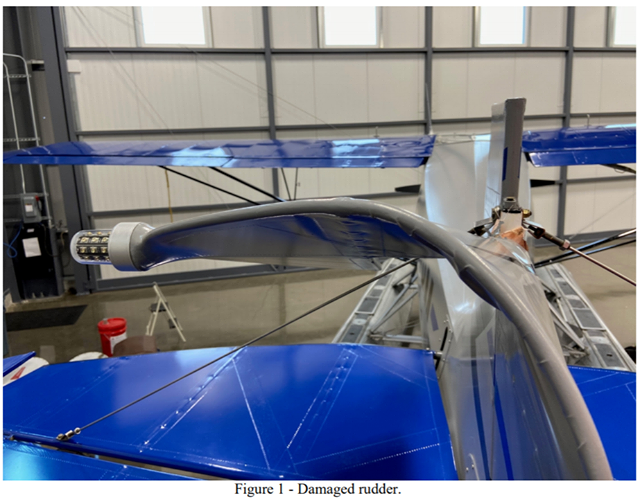The NTSB’s materials lab is now poring over the rudder of a Piper Super Cruiser that bent almost horizontally in flight in Alaska last June. The board recently issued a preliminary report on the incident, which created some challenges for the two pilots on board but worked out safely in the end. A private pilot was getting float flying lessons from an instructor and the two took off from Lake Hood Airport to practice water work on nearby Twin Island Lake last June 8. With the student flying, the aircraft made a normal water landing on the lake and took off again. He was on the crosswind, intending to stay in the pattern for another landing, when the aircraft suddenly yawed to the right.
The instructor took control and quickly established that yaw control was all but lost and the aircraft was trying to climb. He pushed forward on the stick and dropped the water rudders to help stabilize the aircraft and headed for the airport rather than attempting another landing on the lake. After the safe landing, they saw the rudder separated from the stabilizer and flopped over to the left. “An initial examination of the rudder revealed that the vertical spar tube separated just above the upper hinge point and the top portion of the rudder folded over the horizontal stabilizer tail brace wires,” the preliminary report said.




































Having part of an in-flight aircraft lose an essential flight control is not a challenge, it’s a problem.
Reading this report gave me a strong feeling of deja vu: I experienced a similar failure in a PA-18 Super Cub about 40 years ago: as in this case, the rudder’s vertical spar tube separated just above the upper hinge point and the top of the rudder folded over the stab brace wire. The only difference was that my rudder folded over to the right. Interestingly, the aerodynamic result was the same: the airplane pitched up and to the right, which was fortuitous as I had been climbing in turbulent air along a ridge line to my left in Wyoming’s Big Horn Mountains, taking advantage of the ridge lift generated by a strong wind from my right.
The Super Cub was set up as a glider towplane with a rearview mirror that afforded a view aft through the overhead window, so I was able to see that the top of the rudder was missing—though not that it was still attached. The rudder pedals were all but immovable. I climbed up and over the ridge and, not knowing if I’d be able to avoid a ground loop after touchdown, declared an emergency and made a precautionary, dead stick landing on Sheridan’s big runway, the only time in my fifty-plus year flying career that I’ve had the crash trucks roll on a landing of mine. Once the airspeed dropped and the aerodynamic loads lessened I found that I had some rudder movement and tail wheel steering control, so I was able to stop straight ahead on the runway, restart the engine and taxi to the ramp.
We concluded at the time that it was the big, heavy aftermarket beacon mounted atop the rudder that had induced a fatigue failure of the rudder’s spar tube at the hinge weld. Note that in the photo that accompanies this article, the Super Cruiser also has an aftermarket beacon mounted atop its rudder. I think I’ll drop the NTSB a note…
February 9, 2022 : ( NTSB) Our evaluation showed that the peak stresses on the nominal rudder post
approach the endurance limit of AISI 1025 steel.7 All five of the fractured rudders the NTSB
evaluated had an aftermarket beacon or strobe installed on the top of the rudder
post. The additional surface area and mass of a beacon or strobe would likely
increase the stresses even further. https://www.faasafety.gov/files/notices/2022/Feb/AIR2202.pdf
I surely can understand how a beacon on top of the rudder can fail the tube with the turbulent vibration.
Reminds me of my one and only “save” a few years back. I was at a small field watching friends skydive. I saw a straight tail 150 taxi past and noticed the tail was only attached by the lower hinge. I chased after them and caught up to them at the run-up pad. Probably scared the crap out of them when I started banging on their door mid run-up. They got out and looked and taxied back to parking. Would havee been really exciting if they had got up to takeoff speed.
Alaska is notorious for having queer problems and bad maintenance. I hope they don’t made an AD because of this!